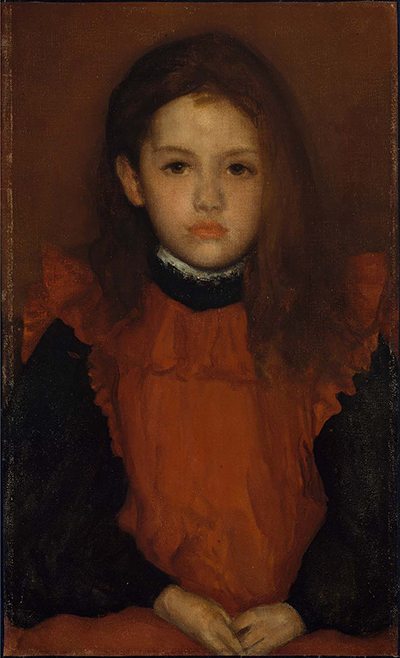The Little Rose of Lyme Regis was painted by the American, James Abbott McNeil Whistler, 1834-1903, in 1895 in the coastal resort town of Lyme Regis, West Dorset, England, in which country the artist was to spend the rest of his life after arriving there at the age of twenty-five.
This charming, but rather bland and unremarkable, full-face, half-length portrait now resides in the Museum of Fine Arts, Boston, Massachusetts, U.S.A., after being sold to it in 1896 by Wunderlich Galleries of New York. The size is h.51.43 x w.31.11cm. and the medium is thin layers of oil paint on canvas. The sitter is a timid and innocent eight-year-old girl, Rosie Randall, the daughter of the town's mayor. However, this work was not commissioned. It was, amongst a few other studies, created as a sincere compliment to the children Whistler referred to as "the little Lyme Regis maidens" (see the letter to his wife, Beatrix, dated 10 November 1895).
With her hands anxiously clutched together on her lap, sweet little Rosie softly emerges from the darker background in her red pinafore, blending subtly into the colours of her lips, eyes and hair, over a black dress. This work, however, contrasts significantly with the prevailing saccharine sentimentality evident in most earlier Victorian child portraiture. Rosie's eyes are slightly asymmetrical, the result of the rapidity with which Whistler painted. He was certainly not a slave to realism.
The Little Rose of Lyme Regis was painted in the latter stages of Whistler's career and the tonal diffusion of paint is innovative and impressionistic. Indeed, Whistler is now considered the founder and leading proponent of Tonalism, an artistic style and technique that emerged in the 1880s. Tonalism emphasised the harmonising and unifying of dark neutral hues to dominate compositions, creating overall abstract moods. As usual, in this work, Whistler uses a very limited palette. He abandons the purity and intensity of high-key colours in favour of a much more sombre tonal uniformity. This was very much in keeping with the new unfettered approach of "art for art's sake". There are some elements here that remind us of John Singer Sargent paintings.




